
The western grey kangaroo, also referred to as a western grey giant kangaroo, black-faced kangaroo, mallee kangaroo, and sooty kangaroo, is a large and very common kangaroo found across almost the entire southern part of Australia, from just south of Shark Bay through coastal Western Australia and South Australia, into western Victoria, and in the entire Murray–Darling basin in New South Wales and Queensland.

The sooty oystercatcher is a species of oystercatcher. It is a wading bird endemic to Australia and commonly found on its coastline. It prefers rocky coastlines, but will occasionally live in estuaries. All of its feathers are black. It has a red eye, eye ring and bill, and pink legs.

The dusky caenolestid, also known as Tate's shrew opossum, is a shrew opossum from South America. The dusky caenolestid is characterized by a dark brown coat with a lighter underbelly, soft and thick fur, and a loosely haired tail. A nocturnal animal, the dusky caenolestid lives on trees and feeds on insects and small invertebrates and vertebrates. It occurs in alpine and páramo forests in northern and western Colombia, Ecuador, and western Venezuela. The IUCN classifies this shrew opossum as least concern.

The lava gull, also known as the dusky gull, is a medium-sized gull and a member of the "hooded gull" group. It is most closely related to the Laughing gull and Franklin's gull and is the rarest gull in the world. It is endemic to the Galapagos Islands.
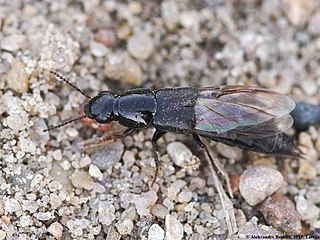
Quedius fuliginosus is a beetle found in Britain and, possibly by traveling in dry ballast, North America. It is similar in appearance to Quedius curtipennis, which is a more common species, however, the eyes of fuliginosus are more convex and the basal antennal segments darker. The punctures on the elytra are slightly stronger in curtipennis.
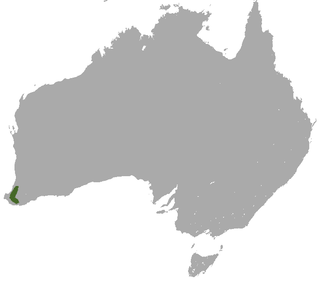
The sooty dunnart is a species of dunnart found in Western Australia. It is one of the least-known of the dunnarts, with the IUCN classifying it as data deficient. It was formerly believed to be a subspecies of the common dunnart.
The Palawan scops owl is an owl endemic to Palawan in the Philippines. There are no subspecies besides the nominate.

The black-throated grosbeak is a seed-eating passerine bird in the tanager family Thraupidae.
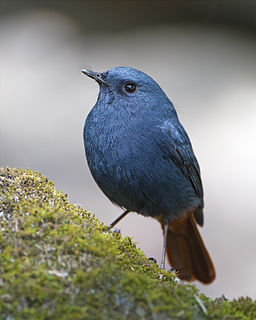
The plumbeous water redstart is a passerine bird in the Old World flycatcher family Muscicapidae. It is found in South Asia, Southeast Asia and China. Males are slate blue in colour, while females are grey. The bird's common name refers to its colour which resembles lead. They tend to live near fast-moving streams and rivers.
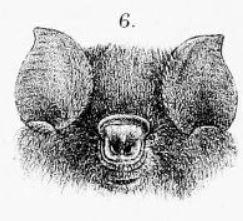
The sooty roundleaf bat is a species of bat in the family Hipposideridae. It is found in Cameroon, Democratic Republic of the Congo, Ivory Coast, Gabon, Ghana, Guinea, Liberia, Nigeria, Sierra Leone, and Uganda. Its natural habitats are subtropical or tropical moist lowland forests and moist savanna. It is threatened by habitat loss.
Agrisius is a genus of moths in the subfamily Arctiinae.

Apostictopterus is a genus of skippers in the family Hesperiidae. It contains only one species, Apostictopterus fuliginosus, which is found in India (Assam) and West China.

The sooty grunter, also known by the name black bream, blubberlips, Northern grunter or purple grunter, is a species of freshwater ray-finned fish, a grunter from the family Terapontidae. It inhabits coastal and inland freshwater creeks and rivers of northern Australia.
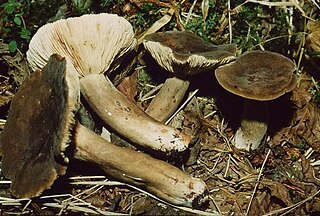
Lactarius fuliginosus, commonly known as the sooty milkcap, is a species of fungus in the family Russulaceae. The medium-sized fruit bodies have velvety, grayish-brown caps and crowded gills. It is found in deciduous forests of Asia, Europe, and North America.
Honorinus is a monotypic snout moth genus described by Carl Heinrich in 1956. Its only species, Honorinus fuliginosus, described by the same author in the same year, is found in Peru.
Agrisius guttivitta is a moth of the subfamily Arctiinae first described by Francis Walker in 1855. It is found in Sikkim, India.
Asura strigibasis is a moth of the family Erebidae. It is found in Vietnam.
Agrisius vernalis is a moth of the subfamily Arctiinae. It is found in China (Guangdong).
Agrisius similis is a moth of the subfamily Arctiinae. It is found in China (Yunnan).
Agrisius albula is a moth of the subfamily Arctiinae. It is found in Myanmar.











